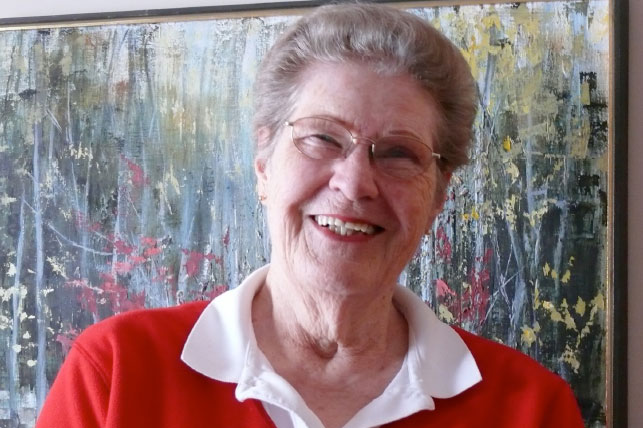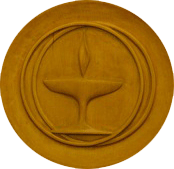
PROFILE: RUTH PATRICK
-
Born 1923, Weyburn, Sask.
-
UCE Activities
-
1st nursery schoolteacher; Fellowship Committee; Chair, Building Committee for 110th Ave. church; Board member, then President (1978-79); Chaplain for 11 years; Board member, then President of CUC (1984-85); member of CUC Chaplaincy Review Committee (2001-02)
HOME / OUR HISTORY / TIMELINE / MINISTERS / PROFILES / PHOTO ALBUMS / CONTACT US
Ruth Patrick / Dorothy Keeler / Jack Ratcliff / Ada Nanning / Clarence Collins / Mary Nimmons / Phyllis Ferguson
Marion De Shield / Annabelle & Maurice Bourgoin / Frances Blythe / Bernie Keeler / Morris Simons
Helen Ready / Mary Ayres / Bill Brown
Ruth Patrick: The Quintessential Unitarian Universalist |
||
BY CHRISTINE MOWAT
|
||
|
Ruth’s story of becoming a Unitarian Universalist is the story of a search for herself. As a child and a teenager she had been active in the United Church, and when she went to college she even expected to become a deaconess. Instead, she discovered social work , and then a set of values that better matched her own convictions. The fight for self Ruth did not want, as she said, “God shoved down my throat, or virgin birth, or a whole lot of other nonsensical stuff. Or the holy trinity: that was probably the first go-round. No way did that make any sense. And that silly song, He sees the sparrow fall – that didn’t either.” Then, soon after, a tragic community incident occurred while Ruth was working at the Winnipeg Family Bureau. Ruth was 28 or 29 at the time. Yet it wasn’t until she moved to Edmonton and was married that she began attending every Sunday – and with the fellow who had taken her to the church in Winnipeg, now her husband, Freeman Patrick. She also described how she felt as a new member. “There is a stage when you first learn about Unitarianism, where you feel it's very, very free. You don't have to believe a lot of things. There isn’t a creedal statement. But on the other hand, having been deeply involved in it for some 55 years now, I’m convinced that it’s something you work at. The more you grapple with the issues and think your way through them, the more satisfying it is and the more committed you become. I think this life process has given me at this age absolutely no fear or anxiety of death, which I think I would have had under the old system if I'd stayed there.” Changes in the church over the years Ministers Connections to national and international organizations “I'm not suggesting that's changing. It maybe only changes form; it's still a strength in our congregation. But I think we were so aware of the support we were getting then from the American Unitarian Association, and from the support that came from the British Unitarian and Free Church organization, the positive good wishes to that. Our congregation as a whole was always conscious of that. I think as we've grown larger and moved away—even though the CUC is very much alive in lots of ways in the church—I don't think the newer members will have quite the same sense of connection. Much more our church is an entity in and of itself for them, whereas for me it's always very connected to a bigger picture.” Ruth attended a number of assemblies in the States, and recalled how fellow members had struggled to get the Canadian flag up on the platform, to get Americans to talk about “we the continental, not just us, the U.S.” By the time Ruth attended “it was still their national conference, but in an international glove!” She loved the conferences, calling them “absolutely marvellous”! Her first was to Bowden, Maine with 1,700 people, and she remembered her exhilaration over the “big supper”. Each attendee, and even the volunteer staff at the college where the conference was held, was provided with “our own lobster and clams and cobs of corn”! In Phoenix and Spokane, there were well over 2,000 people. Ruth has very positive feelings about American Unitarians, and the Unitarian Universalist Association (which replaced the AUA), because of the support in getting our church started. “On the other hand,” she noted, “I also knew that if we did not move forward to an independent Canadian organization, we would always be the country cousin, never really carrying our own weight. And we would never have grown if we kept seeing ourselves as a little appendage.” Women’s programs in the church The UUWF as Ruth knew it put out excellent programs and encouraged women. There were theology programs with awards. There was a small chapter in the Edmonton church, the Berneice Hollinshead chapter of the UUWF. That is now lost, and it happened before the UUA and the CUC division. CUC never tried to form a parallel to the women's group. Ruth emphasized that at the women's gathering level, just the prairie provinces, they are working hard to get charitable donation status through the CUC. The annual women’s retreat used to have it through the western Canada district before the split. We lost that when the district folded, and there wasn't a mechanism in place to make it happen automatically when the CUC took over. Still part of the women’s gathering, she says they are struggling. Ruth’s convictions about the women’s group shine though her words: “There are many women who can never get out of their own community to attend special functions that relate to the denomination. A woman may have a good salary but, if she's got children,for her to go to a conference and participate actively, she has to pay a sitter. Her costs are doubled. Most people can't afford that if they're raising kids. So I have this strong feeling that it would be wonderful if we had a fund . . . a bursary to help women go. “We need to help women take a more active role. We need a whole variety of programs that would help women advance.” Lovely words from an 87-year-old! (And she’s committee chair of her very large condo complex, too!) A church for heart and mind "No,” Ruth said, “It is more than that, a whole lot more. When I go to church—and it won't happen all the time—I'm hoping that one of the life issues that I may have to grapple with, or am grappling with, is somehow approached, or some light shines on an aspect that helps me work it out. I may get a good intellectual understanding at another type of meeting, but I'm there in my head. If I go to church, I'm hoping that all of me is there. And whatever is being said, I'm hearing through all the senses. And therefore, the big questions of life -- Why am I doing what I'm doing? What is the reason for me today? -- I'm hoping that I can count on finding answers more in church, and that's what I go for. I can hear better lectures in lots of places, but I don't go with my whole self ready to hear it; I'm going with my head primarily. “Does that make sense?” Indeed it did. Ruth Patrick’s final words reinforced her love of her church. She talked about the comfort of being with people of shared sensibilities. “I think sometimes it's surprising. There have been moments when something struck me when we were singing a hymn; it could have been through the right piece of music that was played. Sometimes it's somebody getting up and lighting a candle, and telling why they're lighting it. Sometimes it's just seeing somebody, or, for whatever reason, something that really matters dawns on me there in church. I would say that the totality of our church experiences is an opportunity.” [Interviewed in 2008]
© 2010 Unitarian Church of Edmonton |
||
